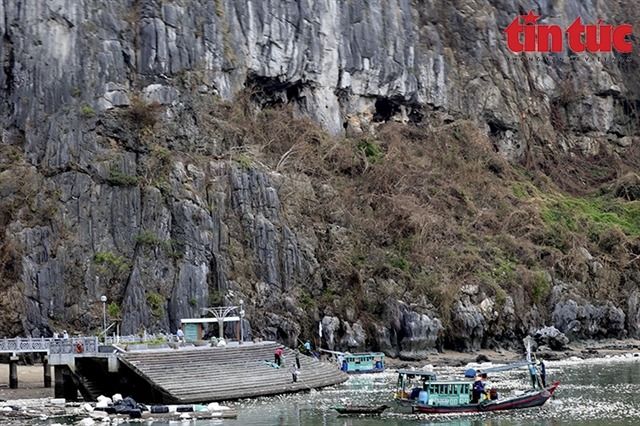What are the specific risks of wildfires in areas hit by typhoons?
Rising Fire Risks and Habitat Disruption: The Aftermath of Typhoons in Halong Bay’s Battered Vegetation
Introduction
Halong Bay, located in northern Vietnam, is famous for its stunning limestone karsts and is a designated UNESCO World Heritage site. However, in recent years, the area has been experiencing an increase in the frequency and intensity of typhoons, resulting in significant damage to the bay’s delicate vegetation. This has led to rising fire risks and habitat disruption, with potentially devastating consequences for the local ecosystem.
The Impact of Typhoons on Vegetation
Typhoons are powerful tropical cyclones that can cause widespread destruction when they make landfall. In Halong Bay, the combination of strong winds and heavy rainfall during typhoons can result in significant damage to the area’s vegetation. This includes uprooted trees, broken branches, and widespread defoliation, which can leave the once lush landscape barren and vulnerable to further environmental threats such as wildfires.
Rising Fire Risks
The aftermath of typhoons in Halong Bay has led to an increased risk of wildfires. The debris left behind by the storms can act as fuel for fires, and the dry, damaged vegetation is more susceptible to ignition. Additionally, the disrupted ecosystem can alter the natural fire cycle, leading to an increased frequency and intensity of wildfires. This not only poses a threat to the remaining vegetation but also puts nearby communities and wildlife at risk.
Habitat Disruption
The destruction of vegetation in Halong Bay has also caused significant habitat disruption for the area’s wildlife. The loss of trees and foliage can disrupt the nesting and foraging habitats of many species, leading to a decline in biodiversity and population numbers. This can have far-reaching effects on the entire ecosystem, as each species plays a unique role in maintaining the balance and health of the environment.
Mitigation Strategies
In the face of rising fire risks and habitat disruption, it is crucial to implement effective mitigation strategies to protect the environment and communities in Halong Bay. This includes:
• Reforestation: Efforts to replant and restore damaged vegetation can help to stabilize the ecosystem and reduce the risk of wildfires.
• Fire Prevention: Implementing fire prevention measures, such as creating firebreaks and conducting controlled burns, can help to reduce the risk of wildfires in the area.
• Community Engagement: Educating and involving local communities in conservation efforts can foster a sense of stewardship and collective responsibility for protecting the environment.
• Wildlife Conservation: Implementing measures to protect and restore wildlife
Assessment of the Impact of Super Typhoon Yagi on Vegetation in Halong Bay
The recent super typhoon Yagi had a significant impact on the vegetation of the limestone islands in Halong Bay. In response to this, the Institute of Ecology and Biological Resources has been called upon to assess the situation and provide recommendations for sustainable conservation and preservation efforts. The aftermath of the powerful storm resulted in extensive damage to the trees on the limestone mountains, with many being uprooted, broken, and dried out.
Risk of Fires and Recommendations for Prevention
The large amount of dried leaves and branches left behind by the storm poses a high risk for fires, especially as the dry season approaches. To address this concern, experts have suggested implementing fire prevention measures such as placing fire prohibition signs and notices in high-risk areas like Dau Go – Thien Cung Cave, Sung Sot Cave, and Ti Top Island – which are also popular tourist destinations.
Findings from Institute Research
According to research conducted by the Institute of Ecology and Biological Resources after assessing various areas within Halong Bay, it was found that 100 per cent of trees in certain locations were affected by Yagi’s devastation. However ,70 per cent have potential for recovery while 30 per cent are unable to recover due to being uprooted.
Impact on Specific Plant Species
The reduction in vegetation cover due to Yagi’s impact will negatively affect endemic plant species such as Halong cycad, Halong palm, slipper orchids (Paphiopedilum concolor), and bong moc (Sinoradlkofera minus). This will also have a detrimental impact on wildlife species’ habitat such as birds,reptiles,and Macaca mulatta monkeys living within these heritage sites.
Restoration Efforts Needed
It is crucial that effective solutions are established promptly to restore vegetation cover across all impacted areas.The head of Halong Bay’s management board,Vu Kien Cuong,stated that complete restoration might take up to 10 years among various islands within Hanoi’s unique heritage site.
